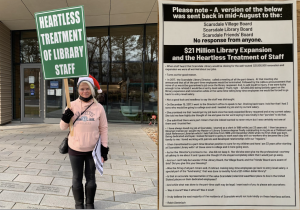AT Spanish Field Trip: “La Casa de Bernarda Alba”
December 12, 2017
Oppression, love, and betrayal are all themes in the classic Spanish play La Casa de Bernarda Alba by Federico Garcia Lorca. Even though the play was written in 1936, these universally relevant themes are why the play has remained one of Lorca’s most iconic works. On Friday, December 8th, Sra. Leech and Sr. Weldon’s AT Spanish Language classes took their annual field trip to see the play in action. For the last several weeks, the classes have studied the language, symbolism, and overarching messages that Lorca inscribed in his play. The studying of the work including acting out scenes, writing reflections, and having socratic seminars. About a week after the classes had concluded reading La Casa de Bernarda Alba, they travelled to El Repertorio Español, a small theater in Gramercy Park that produces plays solely in Spanish, to see the play as directed by Rene Buch.
Overall, the play was phenomenal with every detail from the set, to the acting, to the helpful subtitles projected on a screen, carefully thought out. The play tells the story of the domineering Bernarda, her five daughters, and their maids as they live in a society in which women have little rights and men control everything. Following the death of Bernarda’s husband, she becomes even more controlling of her daughters and does not allow them to leave the house for eight years after the mourning period. During that time, Angustias, the oldest and richest of the daughters is proposed to by Pepe El Romano, the most handsome man in the town, despite the fact that he doesn’t love her and is only after her fortune. However, it is revealed that all of the sisters wish to marry Pepe and the youngest and most rebellious daughter, Adela, has been having romantic relations with him. La Casa de Bernarda Alba tells the story of how people living under oppression can betray even their own family to have a taste of freedom. From the actor’s emotional and physical response, viewers could really understand how oppressed and scared the characters truly were–something that can’t explicitly be understood by just reading the dialogue. “Getting to study a text then actually watch it be brought to life [was the best part,]” commented Anika Arora ’18. An interesting detail was the way in which the set was designed not to look like a house, but instead was constructed of metal chains. Not only did this demonstrate the idea of the house being like a cage for the daughters, but also showed that oppression happens everywhere and at anytime, not only in Spain during that time period. Overall, the trip was a great success and anyone who has studied Lorca’s work or is interested in Spanish plays should see it live.



























